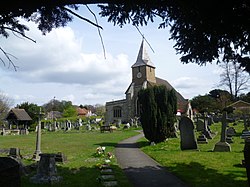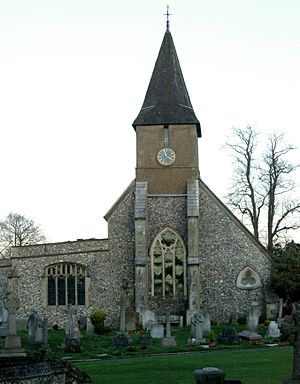Sanderstead
| Sanderstead | |
| Surrey | |
|---|---|
 All Saints' Church, Sanderstead | |
| Location | |
| Grid reference: | TQ337613 |
| Location: | 51°20’9"N, 0°4’54"W |
| Data | |
| Population: | 12,777 (2011) |
| Post town: | South Croydon |
| Postcode: | CR2 |
| Dialling code: | 020 |
| Local Government | |
| Council: | Croydon |
| Parliamentary constituency: |
Croydon South |
Sanderstead is a village at the southern end of Croydon in Surrey, in the county’s Wallington Hundred, at the southern edge of the metropolitan conurbation stretching away to the north.
The village takes in Purley Downs and Sanderstead Plantation, an area of woodland, and stands above a dry valley at the edge of the built-up area of the metropolitan conurbation. The community had a smaller farming-centred economy until the mid 19th century.
Sanderstead's Interwar growth coincided with the electrification of the Southern Railway leaving largely a suburban community of households having at least one commuter to central London or Croydon.
Parish church
The parish church, All Saints, was built from about 1230, though substantial alterations have been carried out in later centuries. [1] It includes several monuments, including a poem attributed to John Dryden, the first Poet Laureate. The church is a Grade I listed building. [2]
History
There is evidence of prehistoric settlement in and around Sanderstead: in 1958–60 the Sanderstead Archaeological Group excavated in the vicinity of Sanderstead pond and revealed the presence of man as far back as the Mesolithic Period nearly 12,000 years ago, as well as pottery fragments dated between 100 AD and 1300 AD and a bronze belt from the end of the Saxon era. North of the village at Croham Hurst, upon a wooded hill, are circular barrows believed to be from a Bronze Age settlement. This is now part of a public open space and the site is marked by a brass monument. A Romano-British homestead (small farming settlement) was discovered during the construction of the Atwood School. During the 1980s, when the school was extended, further excavation revealed the remains of several round huts, hearths, a brooch, and pottery, some of which hailed from North Africa.
An Anglo-Saxon reference to Sanderstead can be found in the will, dated 871, of Alfred, an ealdorman. It later appears to have been given to St Peter's Abbey, Winchester (Hyde Abbey) by Æthelflæd, the wife of King Edgar and mother of Edward the Martyr, where it remained after the Norman Conquest.[3]
Sanderstead appears in the Domesday Book of 1086 as Sandestede, and belonging to St Peter's Abbey, Winchester. It had a noted population (probably of just the adult males) of 26 including 21 villagers, 4 slaves and 1 cottager.[4] Its Domesday assets were assessed as 5 hides, and 10 carucates of arable land. It had 9 ploughs and wood worth 30 hogs. The entry records that in the time of Edward the Confessor it was valued at 100 shillings, and now 12 pounds; and yet it produces 15 pounds.[3]
The village was granted to Sir John Gresham by Henry VIII following the Dissolution of the Monasteries. It was passed to his son Richard who subsequently sold it to John Ownsted, the transfer being ratified in 1591. Ownsted died without issue in 1600, and devised his estates to his two sisters and cousin Harman Atwood, with Atwood subsequently purchasing the shares of his joint legatees. The Atwood family had a long association with Sanderstead, with inscriptions at the local church indicating a presence in the village from the reign of King Edward II.[5]
The manor house, known as Sanderstead Court, was substantially remodelled by Harman Atwood. This large country house was probably first built in the early sixteenth century. The Atwoods continued to occupy the house until 1778, when it was devised to Atwood Wigsell. It was turned into a hotel in 1928, and before the Second World War it was used by the Royal Air Force. It was very badly damaged by fire (not a bomb) in 1944 and was demolished in 1958. One very small part of the hotel building does however still stand. On the site now stands "Sanderstead Court", a three-storey block of flats.
About the village
One of the more curious aspects of Sanderstead is that it has no pub, unlike nearby Warlingham which has around six.
On the edge of the village lies the site of the Old Saw Mill now home to a number of private residences and the picturesque setting for Sanderstead Cricket Club. Cricket has been played in the area since the 18th century, with matches recorded in 1731 and 1732.[6][7] The ground itself has been in use since 1883 and continues to the present day with four teams playing in the Surrey Championship and a number of other Colts and friendly teams.[8]
Located between Limpsfield Road and Kingswood Lane is a large woodland, Kings Wood, which covers some 147½ acres, criss-crossed by ancient rides and is on relatively flat ground. It was purchased in 1937 under the Green Belt Act by the local council and is now public open space. There is the site of a Romano-British settlement on the northern boundary, a small farmstead undisturbed for 2000 years.[9]
Outside links
| ("Wikimedia Commons" has material about Sanderstead) |
- Local guide covering Sanderstead
- Sanderstead Village Community
- Sanderstead Parish (Church of England)
- Sanderstead Evangelical Church
- A gallery of Sanderstead
References
- ↑ A History of the County of Surrey - Volume 4 pp 237-243: Parishes: Sanderstead (Victoria County History)
- ↑ National Heritage List 1079341: Church of All Saints (Grade I listing)
- ↑ 3.0 3.1 Brayley, Edward Wedlake; Britton, John: ’A Topographical History of Surrey’, page 40
- ↑ Sanderstead in the Domesday Book
- ↑ A topographical history of Surrey, by E.W. Brayley assisted by J. Britton ... By Edward Wedlake Brayley, John Britton, Page 41
- ↑ Buckley, G. B. (1935). Fresh Light on 18th Century Cricket. Cotterell.
- ↑ Maun, Ian (2009). From Commons to Lord's, Volume One: 1700 to 1750. Roger Heavens. ISBN 978-1-900592-52-9.
- ↑ "Sanderstead CC". http://sanderstead.play-cricket.com/website/web_pages/80378.
- ↑ "Online communities". 22 January 2016. http://www.croydononline.org/history/places/parks_and_open_spaces/kingswood.asp.
